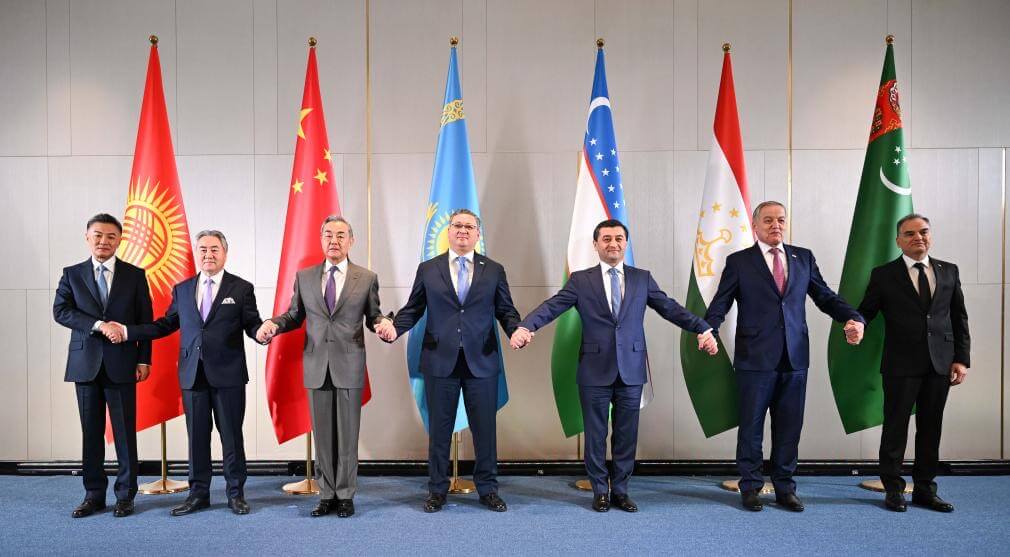Amid the ongoing trade war with the United States, China seeks to strengthen its influence in Central Asia – a region that has traditionally been in Russia’s geopolitical orbit, and where the European Union now aims to increase its presence. But while the EU publicly highlights and promotes its activities in Kazakhstan, Uzbekistan, Kyrgyzstan, Tajikistan, and Turkmenistan, China engages in the region more quietly and without fanfare.

Over the years, the five regional states have established various forms of cooperation mechanisms with different parts of the world. The “C5 + 1″ format – arguably the most significant – has long served as a tool enabling the United States, the EU, Russia, and even Japan, to build closer ties with Central Asia, and achieve some of their geopolitical goals in the strategically important region. China is no exception to this trend.
The regional countries’ relationship with Beijing, however, is shaped to a great extent by geographic proximity. Three out of the five Central Asian states share a common border with China. It is, therefore, no surprise that the world’s second largest economy remains involved in developing connectivity in the region, particularly through projects like cross-border railways and free trade zones.
More importantly, China continues to actively strengthen its economic presence in Central Asia. According to reports, in 2024 trade turnover between Central Asian countries and the People’s Republic reached a record $95 billion. By comparison, the EU’s trade volume with the region in 2022 stood at $47 billion – almost half that amount.
Although the ongoing tariff war between the United States and China can have a significant impact on the world’s second largest economy, policymakers in Beijing seem focused on securing Central Asia’s support. At the sixth China-Central Asia Foreign Ministers’ Meeting, held in Kazakhstan’s city of Almaty on April 26 – just three weeks after the EU hosted a summit with regional states in Samarkand, Uzbekistan – participants praised “the high-level solidarity and mutual trust with China.”
Chinese Foreign Minister Wang Yi put forward five proposals for deepening cooperation between Beijing and the Central Asian countries:
“First, be firm in upholding good faith and fostering harmony. Second, stick to mutually beneficial cooperation. Third, continue to advance institutional development. Fourth, adhere to fairness and justice. Fifth, be firm in friendship for generations”, Yi stressed.
These general phrases were overshadowed by the fact that the ministers agreed to expand trade, expressing their “opposition to unilateral protectionist practices.” This statement clearly suggests that regional countries, at least rhetorically, opposed the tariffs imposed by US President Donald Trump on China and the rest of the world. At the same time, they expressed support for Beijing’s proposal to build a “community with a shared future with neighboring countries,” recognizing the People’s Republic as a “stabilizing force in this turbulent world, serving as a model for multilateralism.”
China’s repeated stance on the tariff war sends a clear message to the United States while also demonstrating Beijing’s alignment with its Central Asian partners, highlighting China’s determination to defend its national interests and what it sees as a “fair international order.” The meeting in Almaty not only helped Beijing gain backing from the regional countries, but also served as comprehensive political preparation for the second China-Central Asia Summit, which is scheduled to be held in Kazakhstan later this year.
China, therefore, seems serious in its ambitions to strengthen its influence in Central Asia, fully aware that it will face strong competition. Not only the EU and the US, but also other actors such as Turkey and Japan, are taking advantage of Russia’s preoccupation with the war in Ukraine to bolster their positions in the region that has long been under Moscow’s geopolitical umbrella.
In other words, with their rich natural resources, key transit location, and growing economic potential, the countries of Central Asia are now increasingly attracting the attention of global powers. The meeting in Kazakhstan’s largest city was not just a formal event. It was an important geopolitical move, reflecting the growing significance of Central Asia in global affairs and the regional nations’ ambition to deepen multifaceted cooperation with China.
They hope Beijing can offer technological expertise and robust production capabilities, along with access to Chinese seaports that landlocked Central Asian countries can utilize. China, on the other hand, needs the region’s natural resources, as well as a stable route for exporting its products to the West. Given that 80% of China’s land-based exports pass through Kazakhstan, in the coming years Beijing will almost certainly continue investing in the infrastructure of the region’s largest country – most likely through increased involvement in the development of the Trans-Caspian International Transport Route (also known as the Middle Corridor), which connects China and Europe while bypassing Russia.
That, however, does not mean that Kazakhstan, Uzbekistan, Kyrgyzstan, Tajikistan, and Turkmenistan will align themselves exclusively with Beijing. The countries of Central Asia are known for pursuing a “multi-vector foreign policy,” aiming to develop relations with all key global players. A meeting with the Chinese Foreign Minister, as well as the upcoming China-Central Asia Summit, does not signify a rejection of cooperation with other powers, but rather represents a pragmatic step aimed toward strengthening ties with Beijing as an important regional partner.
Thus, in the months and years to come, Central Asia – once on the periphery of global events – will undoubtedly assert its role as a strategically important region.
Author: Nikola Mikovic – Journalist, researcher and analyst based in Serbia.
(The views expressed in this article belong only to the author and do not necessarily reflect the editorial policy or views of World Geostrategic Insights).
Image Credit: XINHUA (Sixth Meeting of Foreign Ministers of China and Central Asia held in Almaty, Kazakhstan, April 26, 2025)







